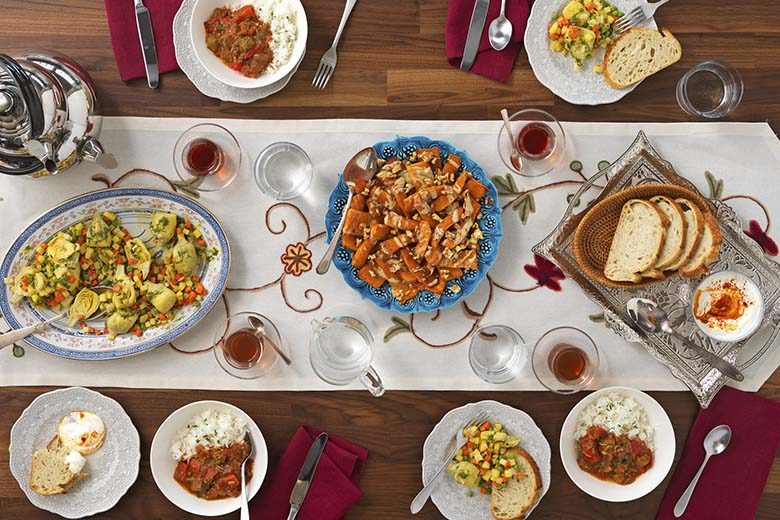
Turkey’s unique location places it in Europe, the Eastern Mediterranean, the Middle East, the Balkan Peninsula and the Caucasus. Geography and the vast migration of Turks from Central Asia to Europe over centuries have shaped Turkish gastronomy.
Because it features a mixture of foods from various cultures and geographical regions, Turkish cuisine is not easy to define. For example, some dishes overlap with other cultures’, which can trigger disagreement over the origin of a specific dish.
Turkey is divided into seven regions, and each region has a different food culture. On the Mediterranean and Aegean coasts, common breakfast foods include feta cheese, olives, eggs, tomatoes, cucumbers, seasonal herbs, olive oil and homemade jam served with Turkish tea. When I lived in the United States, sweet breakfast foods such as cereal and pancakes were foreign to me. Although these foods are sold at Turkish supermarkets, many people prefer the traditional breakfast of their region.
Cuisines of the Mediterranean and Aegean coasts primarily consist of vegetables cooked with olive oil, seasonal seafood and salads. People do not eat much red meat. When cooking vegetables with olive oil and not meat, it is traditional to add a cube of sugar and serve the dish cold. If the vegetables are cooked with meat, the dish is served warm.
In the eastern Anatolian region, typical dishes are cooked with meat, bulgur, herbs and spices — mainly hot ones including maraş and isot chilli flakes. If I meet someone from Turkey who loves spicy food, I immediately ask if they are from the east. Plain yogurt is served at every meal, except with fish. Soup is important in Turkish cuisine. There are summer and winter soups that are served before the main dish and are eaten mostly with bread.
Bread and either white rice or bulgur, depending on the region, are important to Turkish people. It is typical to serve bread at each meal and rice at lunch and dinner. There is a common saying: “You cannot feel full without eating bread.” Mothers tell their children they will have as many kids as the grains of rice they leave on their plates. As a child, I frequently woke to the smell of fresh bread my father bought from the bakery. We would spread butter and honey on it. However, in recent years as the obesity rate has increased in our country, Turkish people have started to cut down on bread and rice.
Fish is a major part of Turkish cuisine, since the country is surrounded by the Black Sea to the north, the Mediterranean to the south and the Aegean to the west. The Black Sea region is famous for its hamsi, a type of anchovy. While there are many ways to cook hamsi, it is generally served fried with a coating of corn flour or cooked with rice in the oven. My father, who is from Trabzon in the Black Sea region, frequently bought hamsi on his way home from work. In their first years of marriage, my mother, who is from Kayseri in the Anatolian part of Turkey, refused to clean the fish. But now, after more than 50 years of marriage, she can do it in her sleep.
During the winter, we eat hamsi at least once a week. It is a small fish that can be eaten whole, as its bones are crunchy and safe to eat. Other than hamsi, most of our seasonal fish is seasoned with salt and lemon and grilled.
After eating fish, dessert is a must. Helva, made with either semolina or flour, is a typical dessert. Baklava, quince and pumpkin dessert also are popular.
For snacks, Turkish people love dried figs and apricots paired with nuts. It is common to see locals carrying them in their handbags or storing them in their cars. Turkey is the world’s biggest producer of hazelnuts, cherries, figs and apricots. While hazelnuts are nutritious and delicious, they are expensive.
Tea, coffee and ayran (a drink made of water, yogurt and some salt) are some of Turkey’s national beverages. Tea is made in a special teapot with two layers: the top kettle holds the black tea granules and boiled water, and the bottom kettle contains plain boiled water. To serve, pour tea from the upper kettle and, depending on how strong you want your tea, then add more boiled water. Sweetening tea and coffee has become less popular, as people are watching their sugar consumption. You can have Turkish coffee plain (without sugar), medium (with a little sugar) or with as much sugar as desired. It is common to add fresh mint or other herbs to ayran.
Family is the main focus of life in Turkey, and family members are expected to sit together for meals. This usually extends to close relatives, friends and neighbors. However, because of the the current COVID-19 global pandemic, meals stay within each household. Since coffee is an important part of Turkish culture and a way of socializing, especially after meals, many people sit on their balcony or in their garden and chat with neighbors as they drink coffee.
A Turkish proverb says “The heart desires neither coffee nor coffee house. The heart desires conversation; coffee is but an excuse.” Thus, while we may need to stay physically distant during the pandemic, we are still close in our hearts as a culture.
References
Turkey is a World Leader in Production and Export of Four Agricultural Products. Republic of Turkey Agriculture and Forest Ministry website. Published August 18, 2019. Accessed June 30, 2020.

